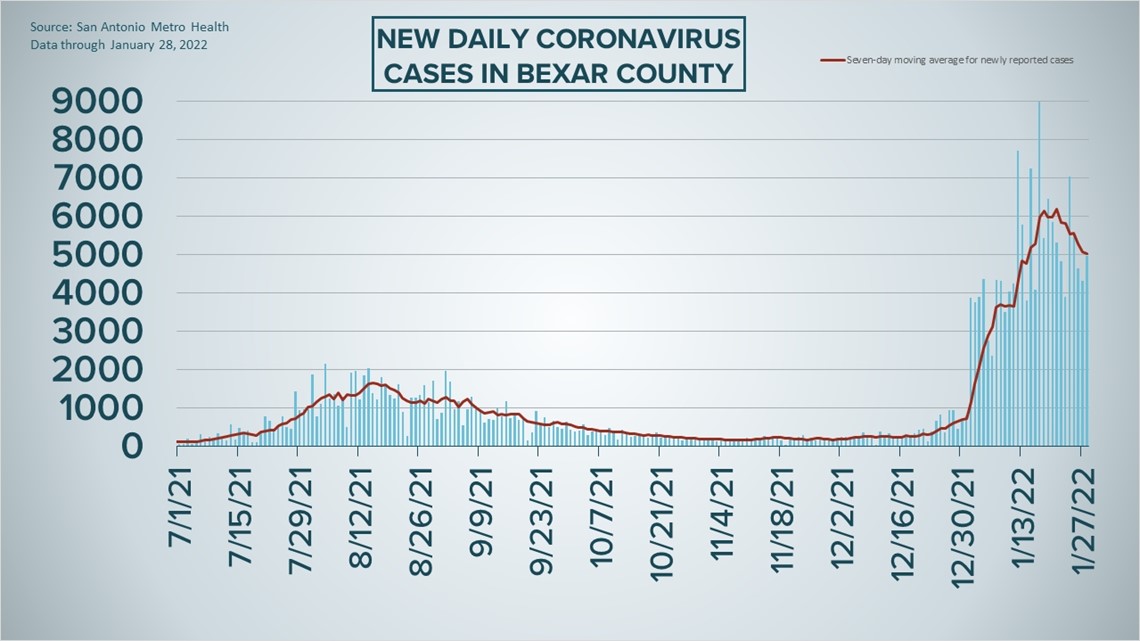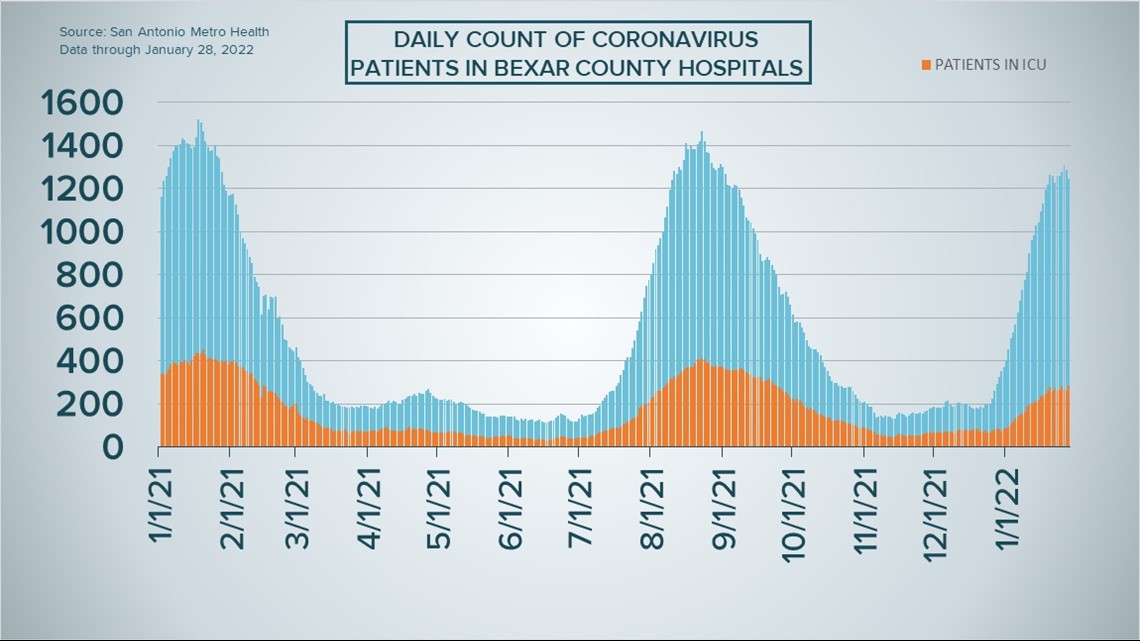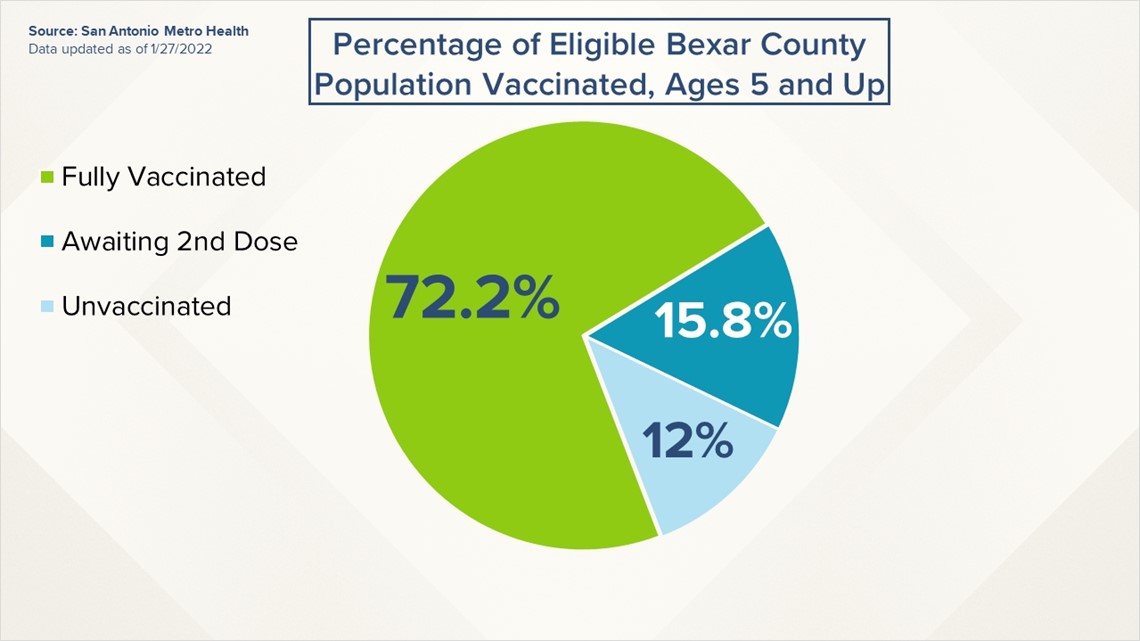SAN ANTONIO — For the third time in the last two weeks, another 15 San Antonio-area residents have died from COVID-19 complications as the pandemic continues and the highly contagious omicron variant continues to spread.
A total of 5,094 have died in Bexar County over the last two years. But coronavirus-related fatality rates have picked up since mid-January, resulting in the first five-day stretch of deaths being reported by Metro Health since early November.
Meanwhile, health authorities tallied another 4,970 new cases on Friday, raising the local diagnosis total to 478,595. The seven-day case average dropped for the fourth straight day, while hospitalizations decreased for a second day in a row.
Of the 1,245 patients receiving treatment for COVID-19 in local hospitals, 282 are in intensive care and 127 are using ventilators to help them breathe. Bexar County hospitalizations are expected to peak sometime in mid-February at around 1,300 hospitalizations, based on the latest data from UT Austin researchers.
How Bexar County is trending




Vaccine Progress in Bexar County
The following numbers are provided by San Antonio Metro Health. A full breakdown can be found here.
- 1.667 million eligible Bexar County residents have received at least one dose of the coronavirus vaccine as of Thursday, Jan. 27, representing 88.9% of the county's population eligible (those over the age of 4) to receive a vaccination.
- 1.367 million eligible Bexar County residents are fully vaccinated as of Thursday, Jan. 27, representing 72.2% of the county's population eligible to receive a vaccination.


The CDC states that "when a high percentage of the community is immune to a disease (through vaccination and/or prior illness)," that community will have reached herd immunity, "making the spread of this disease from person to person unlikely."
The City of San Antonio breaks down the vaccination rates by zip code on Metro Health's Vaccination Statistics page.
Coronavirus in Texas
The total number of coronavirus cases in the state since the pandemic began grew by 38,682 on Friday, according to the Texas Department of State Health Services. That total includes 30,892 new confirmed cases and 7,790 new probable cases. More details can be found on this page.
Friday's figures bring the total number of Texans diagnosed with COVID-19 to more than 6.122 million.
An additional 225 Texans have died from virus complications, meanwhile, raising the statewide death toll to 77,780.
Coronavirus symptoms
The symptoms of coronavirus can be similar to the flu or a bad cold. Symptoms include fever or chills, cough, shortness of breath or difficulty breathing, fatigue, muscle or body aches, headache, new loss of taste or smell sore throat, congestion or runny nose, nausea or vomiting, and diarrhea, according to the Centers for Disease Control.
Most healthy people will have mild symptoms. A study of more than 72,000 patients by the Centers for Disease Control in China showed 80 percent of the cases there were mild.
But infections can cause pneumonia, severe acute respiratory syndrome, kidney failure, and even death, according to the World Health Organization. Older people with underlying health conditions are most at risk.
Experts determined there was consistent evidence these conditions increase a person's risk, regardless of age:
- Chronic kidney disease
- COPD (chronic obstructive pulmonary disease)
- Obesity (BMI of 30 or higher)
- Immunocompromised state (weakened immune system) from solid organ transplant
- Serious heart conditions, such as heart failure, coronary artery disease, or cardiomyopathies
- Sickle cell disease
- Type 2 diabetes
- The CDC believes symptoms may appear anywhere from two to 14 days after being exposed.
Human coronaviruses are usually spread...
- Between people who are in close contact with one another (within about 6 feet).
- Through respiratory droplets produced when an infected person coughs, sneezes or talks. These droplets can land in the mouths or noses of people who are nearby or possibly be inhaled into the lungs.
- Some recent studies have suggested that COVID-19 may be spread by people who are not showing symptoms.
Help stop the spread of coronavirus
- Stay home when you are sick.
- Eat and sleep separately from your family members
- Use different utensils and dishes
- Cover your cough or sneeze with your arm, not your hand.
- If you use a tissue, throw it in the trash.
Find a Testing Location
City officials recommend getting a COVID-19 test if you experience fever or chills, cough, shortness of breath or difficulty breathing, fatigue, muscle or body aches, headache, new loss of taste or smell, sore throat, congestion or runny nose, nausea or vomiting, or diarrhea.
Here's a Testing Sites Locator to help you find the testing location closest to you in San Antonio.
Latest Coronavirus Headlines
- Pfizer starting trials to create a vaccine specific to omicron variant
- No, a scientific study doesn't say you can smoke marijuana to prevent COVID-19
- 5 Caribbean destinations added to CDC 'avoid travel' list
- How to get the most accurate results from a rapid coronavirus test
- Yes, there are ways to determine if a KN95 or N95 mask is counterfeit
- Booster shots needed against omicron, CDC studies show
- A digital divide haunts schools adapting to COVID hurdles

